Creating optimal schedules for your team is no easy feat, as you need to consider multiple employees’ availability, qualifications, and preferences at once. The task can feel like a complicated jigsaw puzzle, which is why many businesses use scheduling apps.
With features to generate schedules, manage time and attendance, and coordinate tasks, these apps can save you precious time and effort.
WhenToWork is a common scheduling solution, but it isn’t ideal for everyone, and many have chosen to seek out WhenToWork alternatives.
Below, I break down the 6 best WhenToWork alternatives to help you find the best one for your business.
What Is WhenToWork?
WhenToWork is a scheduling app that collects employees’ preferences and availability and then creates and publishes shift schedules for everyone to see. Managers can also build schedules within WhenToWork.
When designing schedules, managers can rely on the auto-filling feature to designate the best employee for a shift or offer open shifts that any worker can pick up. WhenToWork has a drag-and-drop interface to enable quick updates to schedules.
Once schedules go live, employees can view their shifts in different formats—like lists, calendars, or charts. They can also request to swap shifts with coworkers.
In addition, WhenToWork helps with tracking hours and employee schedules over time. This means managers can view reports of schedule statistics and receive notifications of any changes to schedules or shifts.
Our Top Picks
-
The best alternative to WhentoWork
-

Good for schedule templates
-

Good for restaurants and food service teams
Why trust us?
Our team of unbiased software reviewers follows strict editorial guidelines, and our methodology is clear and open to everyone.
See our complete methodology
21
Tools considered
13
Tools reviewed
6
Best tools chosen
Why Are People Moving Away From WhenToWork?
While WhenToWork is a widely used scheduling tool, it isn’t perfect. Here are a few key reasons some people are switching to WhenToWork alternatives instead.
First, some users have complained about WhenToWork’s lack of live customer support. In their review, one customer listed “no available live representative when you are facing a current issue” as a con of the software. However, customer service representatives are said to respond to submitted queries relatively quickly.
Other reviewers have said the user interface can be tricky to navigate. “I feel like the user interface on the mobile app could be a little better,” one user wrote. On a similar note, another customer felt that “requesting time off could be a little easier.”
A number of users expressed their desire for additional features or functionalities within WhenToWork.
For example, one reviewer said, “It is somewhat annoying to trade shifts because even if you and a co-worker have agreed on an arrangement, you can only submit a request for supervisor approval and not just orchestrate the exchange.”
Another wrote, “I wish there was an option to track punch in and out.”
Overall, WhenToWork is well-rated, with a 4.5 score on Capterra. But there are many alternatives that may suit your company better. I share my top 6 recommendations below.
The Best WhentoWork Alternatives & Competitors
-
Connecteam — The best alternative to WhentoWork
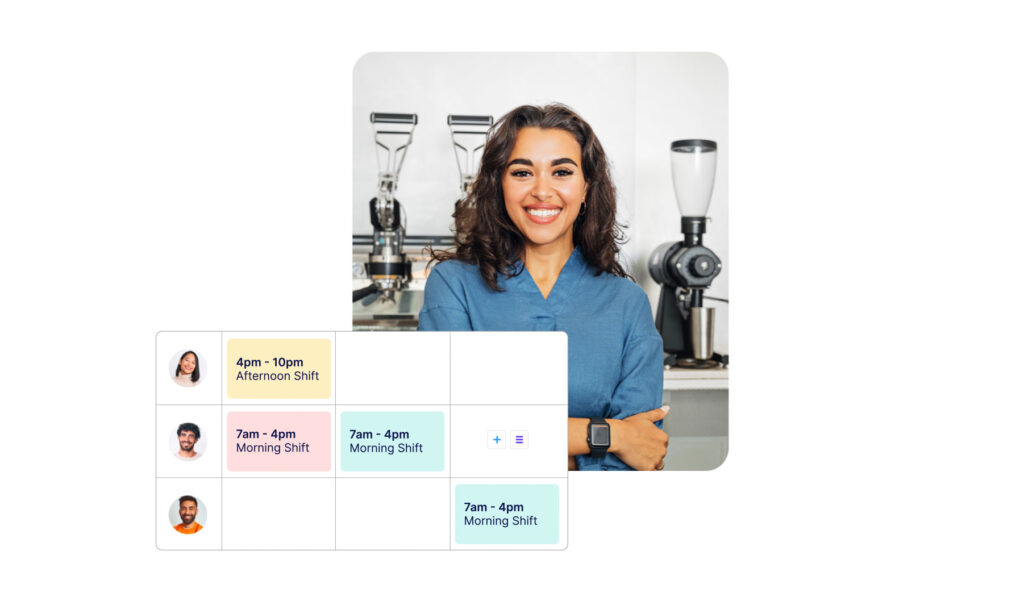
Connecteam is an all-in-one workforce management platform with intuitive employee scheduling features.
Why I picked Connecteam: The platform makes overseeing your team’s schedules simple, doing much of the work for you with automation and templates.
Moreover, Connecteam goes beyond scheduling. Employees can clock in and out from anywhere using the app, and Connecteam helps you with task management, team communication, and more. It even offers 24/7 live customer support if you have any questions.
Read on as I explain why Connecteam is the best WhenToWork alternative.
Fully optimized employee scheduling
Connecteam’s drag-and-drop scheduler lets you create schedules in minutes. Build schedules from scratch, use ready-made schedule templates, or copy past schedules into new reusable templates. You can even set common schedules to recur automatically.
With the scheduler tool, you can assign shifts based on workers’ availability, preferences, role qualifications, or location. Or, simply leave shifts open for any employee to claim.
You can also allow employees to swap shifts—either independently or subject to your approval. Personally, I greatly appreciate the variety of options Connecteam provides here.
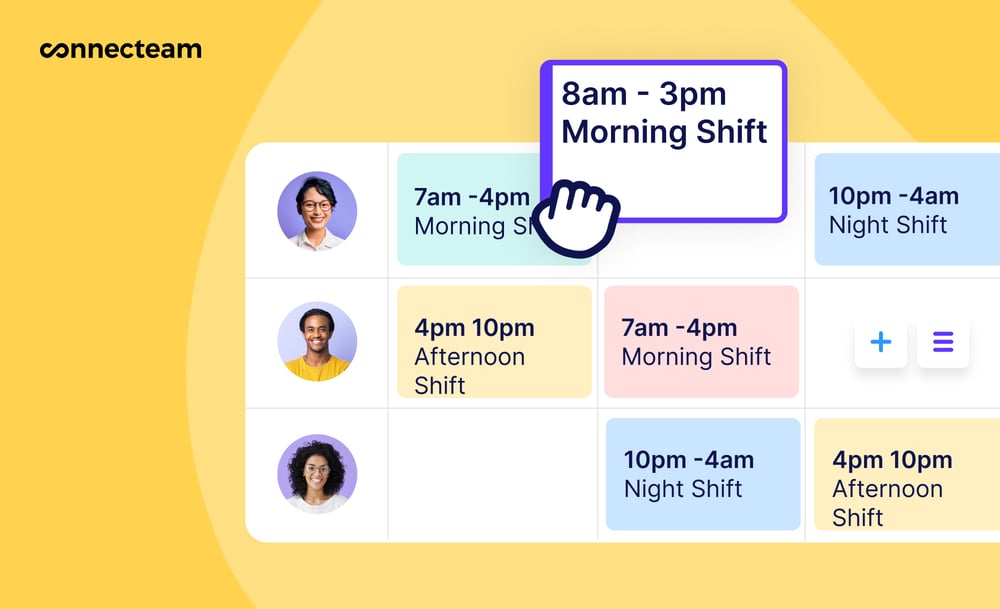
Notifications, custom time policies, and more to ensure your schedules are efficient
Connecteam lets you create custom policies for time off, breaks, and overtime. The software will then automatically add breaks, approved time off, and overtime hours to employees’ schedules, so you can always factor this into planning.
Connecteam will also auto-flag potential scheduling conflicts for you to address before publishing schedules. In addition, Connecteam provides instant notifications about late or absent employees so you can investigate and update your schedules as needed.
The software will also alert you when workers approach unscheduled overtime—a handy function that makes Connecteam stand out, in my opinion. You can instantly see how much overtime an employee has already worked, and then use this information to decide whether to approve or deny new requests. This ensures employees don’t work too much overtime, helping you comply with relevant overtime laws.
Built-in time clock so employees can track time from anywhere
Not all scheduling software offers time tracking or clock-in/clock-out features, but Connecteam has both. For me, this is yet another factor that sets the platform apart from other providers.
Connecteam’s time clock lets your employees sign in and out of work from their mobile devices. It records time automatically, down to the second, and lets employees manually add entries if they forget to log their worked hours.
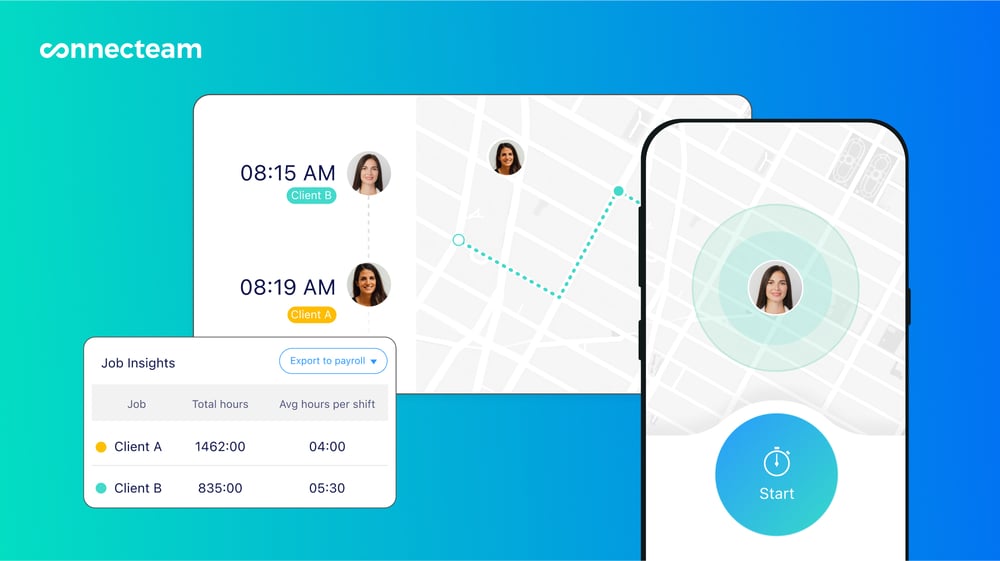
Plus, the time clock has GPS tracking and geofencing functionality built right in. You can get a live look at employees’ locations to ensure they’re in the right places and set virtual borders around job sites to prevent workers from clocking in or out beyond that area.
Easily create tasks and add them to schedules
Connecteam also makes it easy to create and manage tasks and integrate them into employees’ schedules.
After choosing from templates or building tasks from scratch, you can include notes, deadlines, file attachments, and even forms and checklists within each task. Then, you can add tasks directly to shifts. I find this incredibly helpful in ensuring employees know exactly what’s expected of them when they clock in each day.
Connecteam offers full oversight of task progress through the manager dashboard. You can filter current and completed tasks by worker, location, project, due date, and more. Connecteam will notify you as workers finish tasks or when they’ve passed a deadline. You can also send automated completion reminders and progress update requests to team members.

Communicate with your team in real time
Within Connecteam’s in-app chat, you and your team can communicate securely in one-on-one or group discussions. You can chat about projects, ask employees for their availability, share schedule updates, and more—no matter where you are.
Messages can include audio, images, videos, files, and more for streamlined info-sharing. Push notifications alert you and your employees whenever there’s a new message to read, but you can mute conversations whenever needed.
Connecteam also has an updates feature, which functions like a social media feed. You can share posts with specific groups or your entire workforce, track who’s viewing and interacting with your updates, and even schedule posts in advance.
Collect feedback on schedules and availability information from employees
Another feature I find handy for ensuring efficient scheduling is Connecteam’s surveys and polls tools. You can use these to ask for feedback on recent schedules, for example, which can help you identify potential pain points and ways to improve your team’s schedules.
The live digital polls feature, in particular, is ideal for gathering instant responses. So, you might use it to ask for employees’ real-time availability. This way, you can update schedules in emergencies to ensure you’re adequately staffed.
Plus more
In addition to these features, Connecteam has various others to meet all your business needs. There are tools for event management, employee recognition and rewards, training and onboarding, document management, and plenty more.
But Connecteam doesn’t make you decide between having tons of features and sticking to a budget. It’s affordable for businesses of all sizes, with plans starting at just $29 per month for up to 30 users. Connecteam even offers a free-forever Small Business Plan for teams of 10 or fewer workers.
Connecteam also offers a free for life plan – Get Started Now!
Key Features
Pros
Mobile app available for iOS and Android
24/7 customer support
User-friendly interface
All-in-one work management software
Cons
More integrations to come
Pricing
Free-for-life plan availablePremium plans start at $29/month for 30 users
14-day free trial, no credit card required
Start your free trial -

Sling — Good for schedule templates

Sling is an employee scheduling software solution with a few extra work management features.
Why I picked Sling: The platform offers drag-and-drop scheduling and templates for recurring shifts. While building schedules, you can view your employees’ availability to avoid any scheduling conflicts. Employees can also submit time off and shift change requests.
Both you and your team can access schedules from anywhere, viewing and updating shifts via the mobile app. You can also set notifications to alert employees when they release or change schedules.
What I appreciate about Sling is that its functionality extends beyond the scheduling process. It offers additional features like a time clock, task management tools, and employee communication features.
However, I noticed a big drawback. Sling offers a free option, but it provides scheduling tools only. You’ll need to sign up for the premium plan to get the full benefits of Sling. In addition, I found that Sling’s user interface is a bit confusing to navigate.
Key Features
- Drag-and-drop scheduling
- Reusable schedule templates
- Shift swapping
- On-the-go access
Pros
- Integrates with other software like Gusto
- Includes features beyond scheduling
Cons
- Free version offers limited functionality
- User interface isn’t as intuitive as other systems
Pricing
Starts at $2/user/month Trial: Yes — 15-day trial Free Plan: Yes — Up to 50 users (Changing to 30 users from March 1st, 2025)
-

7shifts — Good for restaurants and food service teams
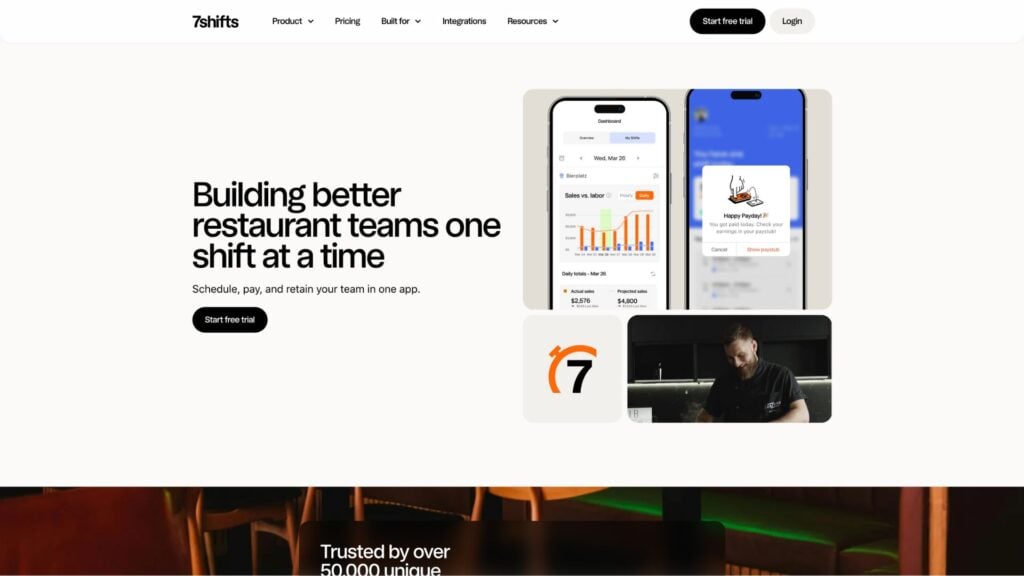
7shifts is a scheduling software system designed for restaurants, bars, and cafes.
Why I picked 7shifts: Employees can use the 7shifts mobile app to keep track of their schedules, update their availability from anywhere, clock in and out, and communicate instantly with the team.
You can use the app to create employee schedules and keep track of availability, time off requests, and shift changes. Plus, 7shifts lets you set tasks, forecast sales, and oversee employee time spent working. The platform also provides tools for the entire employee lifecycle, from hiring to scheduling to payroll, which I appreciate. There are various restaurant-specific features, too, like tracking and paying out tips.
However, a concern for me is that the app can sometimes glitch. In addition, I found that the third-party integrations aren’t as smooth as they could be.
Key Features
- Clock-in and clock-out capabilities
- Schedule creation and management
- Task management
- Employee communication
Pros
- Mobile app for access anywhere
- Offers features for payroll and hiring
Cons
- Doesn’t always integrate well with other systems
- Can be buggy
Pricing
Starts at $29.99/month/location, up to 30 employees Trial: Yes — 14-day Free Plan: Yes — Up to 1 location & 30 employees
-
Buddy Punch — Good for shift swapping
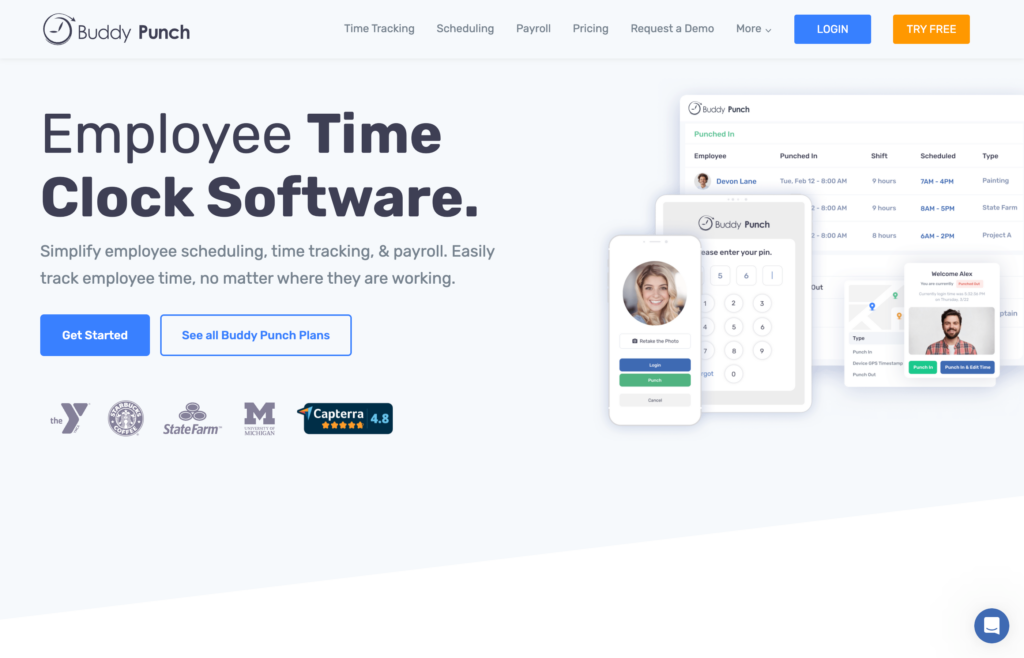
Buddy Punch is a time clock solution that enables businesses to manage employees’ schedules and time.
Why I picked BuddyPunch: Like similar software, Buddy Punch offers a drag-and-drop schedule builder, notifications of schedule updates, and geofencing tools. However, I especially liked its employee-driven shift-swapping function. This lets your workers trade shifts independently, saving you the effort of reviewing and approving requests.
In addition, the software enables employees to clock in and out of work and record their time. You can also set up automatic punch-outs if employees forget to sign out for the day. Plus, Buddy Punch lets you customize and run reports detailing overtime hours, total team work hours for a specified period, and employee shift locations. The platform also offers payroll software integrations.
However, I was disappointed to discover that the Buddy Punch app can sometimes be buggy.
Key Features
- GPS tracking and geofencing
- Ability to clock in via mobile or web
- Notifications for shifts and missed clock-ins
- Drag-and-drop schedule creation
Pros
- Simple user interface
- Responsive customer service
Cons
- Editing past time entries can be challenging
- App can be buggy
Pricing
Starts at $3.99/user/month + $19 base fee/month Trial: Yes — 14-day Free Plan: No
-

Deputy — Good for optimizing schedules

Deputy is an HR software system with various tools for scheduling and time tracking.
Why I picked Deputy: You can design schedules based on employees’ availability and planned time off. Additionally, you can optimize schedules by factoring in employees’ training for tasks, the wage cost of a shift compared to forecasted sales, and more. Then, you can send schedules to your team and set up notifications for any changes.
Deputy also helps uncover replacement options if someone suddenly calls out, which I find a very helpful feature. There’s also an option for employees to swap shifts among themselves via the mobile app.
From my perspective, a drawback of Deputy is that it doesn’t currently have a feature to restrict the locations where employees can sign in. It can also be difficult to integrate Deputy with other software.
Key Features
- Auto-scheduling
- Time tracking
- Task management
- Reporting and analytics
Pros
- Sleek user interface
- Enables shift-swapping
Cons
- Poor integration with other systems
- No geofencing tool
Pricing
Starts at $4.5/user/month, for Scheduling or Time & Attendance Trial: Yes — 31 days Free Plan: No
-
Homebase — Good for updating schedules after call-outs

Homebase provides scheduling, time clock, and employee communication features.
Why I picked Homebase: You can manually or automatically create optimized schedules using team availability, sales forecasts, and labor costs. What I enjoy most about Homebase, though, is that it makes it easy to adjust schedules after an employee calls out of work. You can use the app to find a last-minute replacement or ask the absent worker to secure coverage by swapping shifts with a coworker.
Additionally, Homebase lets employees clock in and out of work, offers GPS-enabled time tracking, can create automated timesheets, and provides payroll integrations. Plus, there’s an employee communication tool and additional features for hiring, onboarding, and retaining employees.
While I like that Homebase offers a free version, its per-user pricing model means costs can quickly add up for larger teams. Read more about Hombase pricing model and platform issues in our honest review.
Key Features
- Templates and auto-scheduling
- Employee shift swapping
- Time tracking and payroll integration
- Employee communication
Pros
- Can change or cancel plan anytime
- Free version available
Cons
- Can get expensive
- Difficult to correct missed clock-ins or clock-outs
Pricing
Starts at $24.95/location/month Trial: Yes — 14-day Free Plan: Yes — For a single location & up to 20 employees
The Best WhentoWork Alternatives
| Topic |
 Start for free
Start for free
|

|

|
|

|
|
|---|---|---|---|---|---|---|
| Reviews |
4.8
|
4.6
|
4.7
|
4.8
|
4.6
|
4.6
|
| Pricing |
Starts at just $29/month for the first 30 users
|
Starts at $2/user/month
|
Starts at $29.99/month/location, up to 30 employees
|
Starts at $3.99/user/month + $19 base fee/month
|
Starts at $4.5/user/month, for Scheduling or Time & Attendance
|
Starts at $24.95/location/month
|
| Free Trial |
yes
14-day
|
yes
15-day trial
|
yes
14-day
|
yes
14-day
|
yes
31 days
|
yes
14-day
|
| Free Plan |
yes
Free Up to 10 users
|
yes
Up to 50 users (Changing to 30 users from March 1st, 2025)
|
yes
Up to 1 location & 30 employees
|
no
|
no
|
yes
For a single location & up to 20 employees
|
| Use cases |
The best alternative to WhentoWork
|
Good for schedule templates
|
Good for restaurants and food service teams
|
Good for shift swapping
|
Good for optimizing schedules
|
Good for updating schedules after call-outs
|
| Available on |
Summary
Effective employee scheduling is a key part of ensuring your business runs smoothly. However, it’s often time-consuming and requires a lot of coordination on your part. Thankfully, scheduling software can take the stress out of creating and overseeing employee schedules.
WhenToWork is a widely used scheduling platform, but some people have moved away from it and begun searching for other software to use.
Of the 6 WhenToWork alternatives I reviewed, my top pick is Connecteam. It offers intuitive schedule creation, task management, time tracking, and a host of other tools. Couple these with the easy-to-use interface and 24/7 customer support, and it’s clear why Connecteam stands out.




